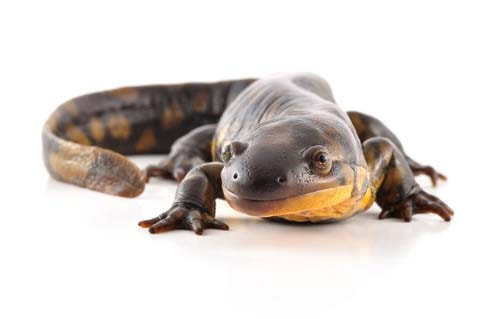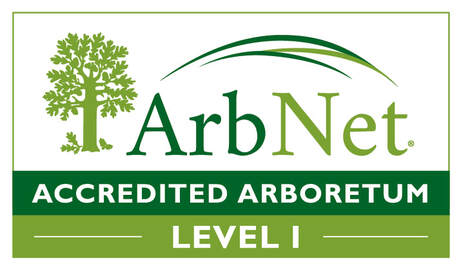Eastern Tiger Salamander (Ambystoma tigrinum)
|
Physical Description: Eastern Tiger Salamander adults have thick dark bodies with spots or stripes of yellow, tan or olive green. Their underside is yellowish or olive in color. As juveniles they tend to be grayish or greenish in color with yellow spots that merge into their adult markings. They have a large head with a broad, rounded snout and round eyes. Their skin is moist and thick, suitable for terrestrial and underground inhabitance.
The Eastern Tiger Salamander grows 7-13 inches on average and weighs 4 ounces. Males are longer than females and have a more compressed tail and longer stockier hind legs. |
Habitat: They live in forests, marshes, and grasslands near permanent sources of water as they require high humidity and wet skin. They will burrow down into the soil, and require moist dirt to do so.
Range: They can be found from Canada down to the Mexican plateau and across much of the United States of America.
Diet: Adults eat worms, snails, insects, and slugs. The larvae and juveniles begin by eating small crustaceans and insect larvae and as they grow, they will prey on tadpoles, smaller salamander larvae, and small fish.
Lifespan: In the wild Eastern Tiger Salamanders live up to 16 years. In human care they can live as long as 25 years.
Social Structure: Females lay eggs in masses in small pools of water and attach them to twigs, grass stems and leaves that have decayed on the bottom floor of the pond. The males will then fertilize the eggs. Each mass can contain up to 100 eggs. Eastern Tiger Salamander eggs are very fragile if handled.
Each female produces from 100 to 1000 eggs per season. The eggs hatch 19 to 50 days after being laid. The hatchings are totally independent upon hatching. The larva remains in the pond until they turn into adults at 2.5 to 5 months of age. Sometimes, adult Eastern Tiger Salamanders remain in the aquatic larval form for their entire lives and do not move on to the terrestrial stage. This is called paedomorphy.
Status: Least Concern1
Other: The Eastern Tiger Salamanders are also known as Mole Salamanders. They are the largest land-dwelling salamander in North America.
Eastern Tiger Salamanders require soil in which they can burrow since they live underground for most of the year. They have been found over 2 feet below the surface. This allows them to escape the temperature extremes on the surface and may explain why they have such a wide array of habitat types.
1 https://www.iucnredlist.org/species/83293207/196342827
Range: They can be found from Canada down to the Mexican plateau and across much of the United States of America.
Diet: Adults eat worms, snails, insects, and slugs. The larvae and juveniles begin by eating small crustaceans and insect larvae and as they grow, they will prey on tadpoles, smaller salamander larvae, and small fish.
Lifespan: In the wild Eastern Tiger Salamanders live up to 16 years. In human care they can live as long as 25 years.
Social Structure: Females lay eggs in masses in small pools of water and attach them to twigs, grass stems and leaves that have decayed on the bottom floor of the pond. The males will then fertilize the eggs. Each mass can contain up to 100 eggs. Eastern Tiger Salamander eggs are very fragile if handled.
Each female produces from 100 to 1000 eggs per season. The eggs hatch 19 to 50 days after being laid. The hatchings are totally independent upon hatching. The larva remains in the pond until they turn into adults at 2.5 to 5 months of age. Sometimes, adult Eastern Tiger Salamanders remain in the aquatic larval form for their entire lives and do not move on to the terrestrial stage. This is called paedomorphy.
Status: Least Concern1
Other: The Eastern Tiger Salamanders are also known as Mole Salamanders. They are the largest land-dwelling salamander in North America.
Eastern Tiger Salamanders require soil in which they can burrow since they live underground for most of the year. They have been found over 2 feet below the surface. This allows them to escape the temperature extremes on the surface and may explain why they have such a wide array of habitat types.
1 https://www.iucnredlist.org/species/83293207/196342827







